If the open road calls to you, the RV Care-A-Vanners are for you. This volunteer program invites anyone who travels by recreational vehicle to make Habitat part of your journey, or even your destination…
— from the Habitat for Humanity website.
The volunteer Care-A-Vanners didn’t come to Archuleta County this summer. That’s a change from last summer, when about 50 of them paid a visit to Pagosa Springs to help build a Habitat for Humanity-sponsored home for the Tusa family.
Not this year, though.
Habitat for Humanity of Archuleta County maintains its office upstairs above the TBK Bank, in downtown Pagosa Springs, with windows looking out on Highway 160 — a segment of the highway otherwise known as San Juan Street. Executive Director Lori Hendricksen and I sat at opposite ends of an eight-foot conference table yesterday, safely socially distanced, and discussed the non-profit’s upcoming plans.
Since its founding in 1994, the Archuleta County affiliate of Habitat for Humanity International has managed to construct about one single-family home per year, for a qualifying Archuleta County family, and more recently has also been helping families repair existing homes — 29 existing homes, thus far.
Ms. Hendricksen finds it easy to talk about the organization’s achievements, and its current challenges. As with many non-profits in the time of the cornonavirus pandemic, the challenges seem to be outweighing the achievements at the moment.
“We rely on volunteer workers to build our homes, and about 40 percent of that volunteer labor comes from the Care-A-Vanners. And I think you’re familiar with them from the article that you wrote last year…”
That Daily Post photo essay documented a group of Care-A-Vanner volunteers working on the 27th Archuleta County Habitat house built last summer — a cozy, 1,150 square foot, three bedroom for Pagosa resident Brandy Tusa and her three kids.
Ms. Hendricksen:
“Habitat International suspended the Care-A-Vanners program through the end of 2020, because of concerns with COVID. And the one thing, when you’re relying on volunteer labor, you have to be in close proximity when you’re teaching people how to do things. So the concern about being socially distanced, and the incremental cost of PPE, and different things like that… that’s why that program was suspended. Hoping that it will start up again next year, just depending on what goes on with that.”
Some Habitat affiliates are continuing to build this summer, but are using paid labor. That approach is not feasible here in Pagosa, and as a result, construction of the planned 28th home will not begin until next May at the earliest.
“We’re a very small affiliate… we get donations and grants to help with our builds, and one thing we do well is make use of USDA construction loans, which convert into a mortgage for our homeowners. And there’s income that comes from that, mainly for administration and general contracting… All of those things are being impacted…
“But we’re still keeping busy, and this gives us a chance to step back, and work on our fundraising and our outreach to major donors, and applying for grants and things like that. So we’re going to be better organized and ready for next year. We’re very optimistic about next year…”
And finding a new source of labor? Kids from the new Pagosa Springs High School construction trades program?
“We’re working with ‘Build Pagosa’ and we’ll soon be talking to the school district about taking some of the students from the building trades programs and offering paid apprenticeships, which I’m thrilled about, because that’s addressing a very important need in this community, which is teaching our young people construction skills. We’ve got a shortage of those in this community. And bringing kids into Habitat, because a lot of our volunteers are… older…”
She gave a laugh.
A lot of everyone in Archuleta County — not just the volunteers — are ‘older’. This community is one of the ‘older’ communities in Colorado, with an average age of about 50, compared to Colorado’s average age of about 37.
“Another impact from COVID we’ve had — and many other non-profits also — is, that some of the resources… the grants and donations, important parts of our income stream, so many of the national foundations and granting agencies have focused on immediate COVID relief, as they should. But that had taken away the opportunity for us to continue our regular operations.
“So we’re a little bit challenged by that… But now some foundations are starting to do what they call ‘recovery’ for non-profits, to help us with operational expenses and things. The Community Foundation for Southwest Colorado — we just received a grant from them, and we’re very grateful for that.
“So what had been potential funding, to come to Habitat or other non-profits, has been diverted to immediate COVID needs. And then we’ve got incremental expenses for PPE also, that we need to provide to our volunteers. So it’s been a challenge. Fortunately, things weren’t dire for us, financially. We can get through this year. But we need to do a build next year to keep the cash flow moving…”
It’s been a challenge for many non-profits to keep the cash flow moving this summer. For so many reasons.
The key word, for many of Pagosa’s charitable organizations, is “recovery.”



